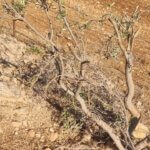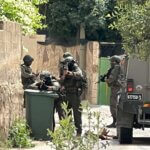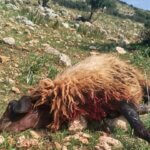Call for action: stop the demolition of Palestinian homes in Al Hadidiya
 Once again the Palestinian community of Al Hadidiya, is under threat of demolition. Please take action to stop this ethnic cleansing.
Once again the Palestinian community of Al Hadidiya, is under threat of demolition. Please take action to stop this ethnic cleansing.
Three family homes are under immediate threat of demolition and Jordan Valley Solidarity believes this could happen at any time now that the major military training in the Jordan Valley has wound down. All the other families in Al Hadidiya have also received demolition orders and are still challenging the in the occupation court.
This community have been subjected to home demolitions more than a dozen times between 1997 and 2011: In June 2011, the Israeli military demolished 13 structures, leaving 37 residents homeless, and undermining the livelihood of another 15. On that occasion they had also been to the military occupation court and the judge had ordered that the demolitions should not happen. However, the army still came and carried out the demolitions. When Abu Sakr, one of the local residents, showed them the papers from the court confirming that the demolition order had been overturned the Israeli soldier said to him: “You can put that in the water and drink it” illustrating how worthless a court order is if it favours a Palestinian. The homes were demolished.
As Abu Sakr said to us: “The soldiers are Israeli and the court is Israeli.”
The community rebuilt their homes with the support of Jordan Valley Solidarity, but once again they are under threat.
This was followed by an international campaign to save Al Hadidiya, supported by Amnesty International and many other large NGOs.
Then, on 10th November 2011 the occupation forces issued demolition orders for 17 structures (nine home, plus animal shelters and kitchens). However, to date these have not been carried out.
The community came together and challenged the demolition orders in court. But, on 22nd February 2015 their lawyer, Tawfiq Jabareen, called the people and told them that the orders to demolish the homes and animal shelters of four families have been authorised by the court. So these homes could be demolished at any time.
JVS met Ghrazi, one of those whose home could be demolished any day now, on 30th April 2015. He is just 25 years old and lives with his wife, Russia, and two young children (a 2 year old girl and a 6 month old boy). They have sheep and chickens and earn a living by making cheese with the sheep’s milk. They are only just able to survive this way, mainly because it is so expensive to take the cheese to the market in Nablus.
Ghrazi’s greatest worry was that his lambs would not have any shelter from the sun if the occupation forces come to demolish his home and other buildings. Last time his home was demolished, 6 years ago, he had 150 lambs and 50 of them dies because they were exposed to the sun with no shelter. He said that the one thing that would help him to stay if the demolition happens would be immediate help within a few hours from JVS, to create a new shelter for the lambs. he said that demolitions always happen when it is very hot or very cold, and this is when it is hardest for families to rebuild their homes and resist the ethnic cleansing.
Background
Al Hadidiya was a thriving farming community before the occupation of 1967, with around 160 families living in traditional stone-built houses. In 1997 they were driven from the land that they owned and had no choice but to settle several kilometres away – moving into makeshift tents. They have been forced to live like this for the last 18 years, with the occupation authorities systematically denying them the right to build any permanent structures, or to have running water, electricity, schools, health care or roads. The remaining families have stood firm and refused to leave their life on the land, rearing sheep, goats and chickens, and making cheese to earn a living.
This community is being ethnically cleansed. By the time of the demolitions in 2011 there were just 14 families left in the community – today there are just 12 families living there. The area where they now live has been declared a ‘live firing zone’ by the occupation forces, and military exercises using heavy tanks and live ammunition are regularly held within a few hundred metres of people’s homes. They are overshadowed by a military base on the hill above them, and by the illegal Israeli colonies of of Ro’i and Beqa’ot which have appropriated 3000 dunums of agricultural land around them.
What you can do
We are appealing to all our friends to take action to support the people of Al Hadidiya.
Come and stay in Al Hadidiya, in the Jordan Valley, Palestine, the support the community (see our volunteering page for more info)
- Make a donation so that we can help rebuild Al Hadidiya if these homes are demolished (see our donate page for more info)
- Write to your elected representatives:
Ask them to make representation to the Government Minister responsible for Foreign/International Affairs requesting that pressure be brought on the Israeli occupation forces to stop the demolitions in Al Hadidiya and throughout the Jordan Valley - Contact any oganisations you are a member of (for example, Amnesty International, Trade Union, church groups) and ask them to speak up for the right of the children of the northern Jordan Valley
Further information about Al Hadidiya
(from http://www.btselem.org/jordan_valley/al_hadidiyeh)
 The village of al-Hadidiya is located in the northern Jordan Valley, near the settlement of Ro’i, on land leased from residents of Tubas. The village’s approximately ninety residents earn their living as shepherds and farmers. The village is not hooked up to the water grid and its average water consumption is twenty litres per person per day – far less than the 100 liters per person per day recommended by the World Health Organization. The village is cut off from any regular water supply despite its proximity to a Mekorot (Israeli national water company) pump (Beqa’ot 2), which provides water to the nearby settlements of Ro’i and Beqa’ot. The per diem water allotment per person in these settlements, for household use alone, is over 460 liters – at least 23 times the consumption of water in al-Hadidiya.
The village of al-Hadidiya is located in the northern Jordan Valley, near the settlement of Ro’i, on land leased from residents of Tubas. The village’s approximately ninety residents earn their living as shepherds and farmers. The village is not hooked up to the water grid and its average water consumption is twenty litres per person per day – far less than the 100 liters per person per day recommended by the World Health Organization. The village is cut off from any regular water supply despite its proximity to a Mekorot (Israeli national water company) pump (Beqa’ot 2), which provides water to the nearby settlements of Ro’i and Beqa’ot. The per diem water allotment per person in these settlements, for household use alone, is over 460 liters – at least 23 times the consumption of water in al-Hadidiya.
Before the Israeli occupation of the West Bank, residents of al-Hadidiya lived a few kilometers east of the village’s current location, but the site was declared a firing zone and the residents were ordered to vacate it in 1997. A petition to the High Court of Justice the residents filed against the expulsion was rejected in 2003, and they were forced to leave. However, the Civil Administration issued demolition orders for structures built in the new location as well, claiming it was agricultural land. A petition the villagers filed in March 2004 against the Civil Administration’s policy in their village was rejected in December 2006, after the Court declined to intervene in the considerations of the Civil Administration. The justices accepted the arguments presented by the military and the Civil Administration for prioritizing the evacuation of al-Hadidiya: a security argument regarding the village’s proximity to the settlement of Ro’i and a planning argument, based on the concern that the tents are in fact “the beginnings of a village”, contrary to the area’s agricultural zoning.






